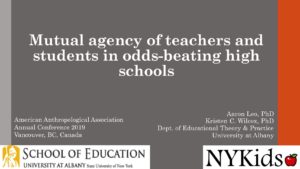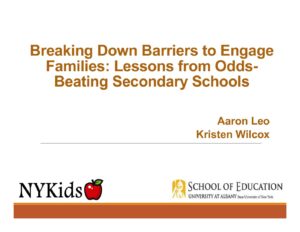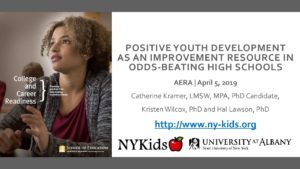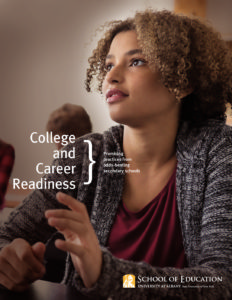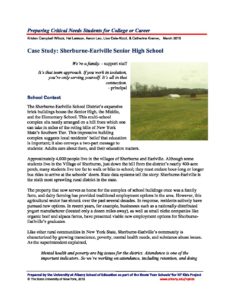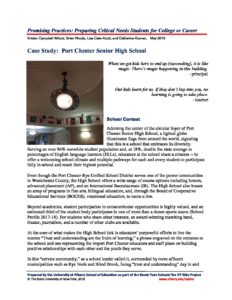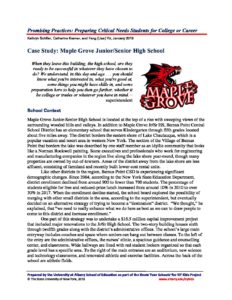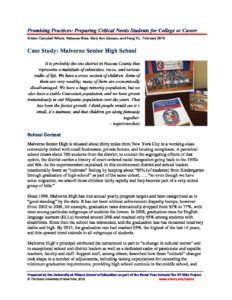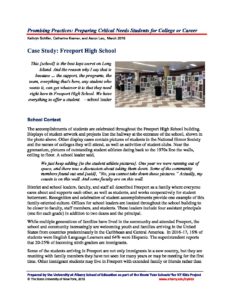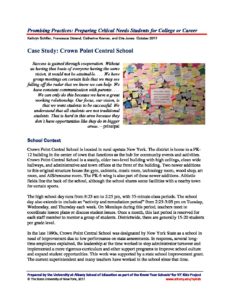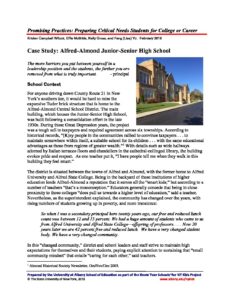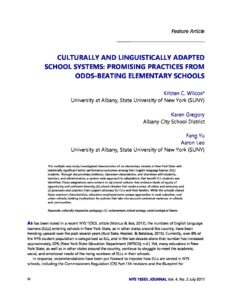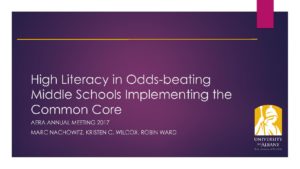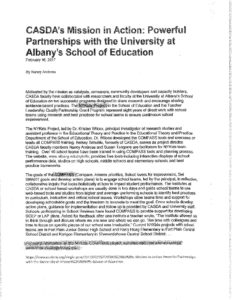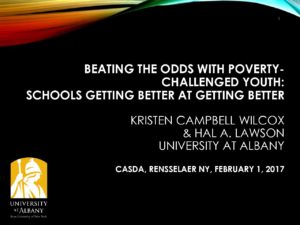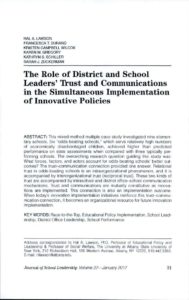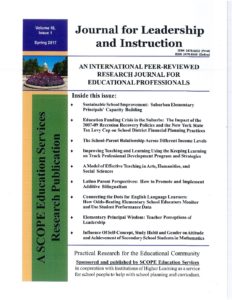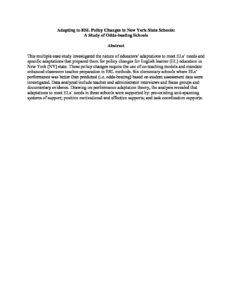A primary activity of NYKids is to conduct research and identify promising practices in odds-beating schools.
Results of each study are available in multiple formats and include reports that summarize the results of each study; best practice frameworks that offer comparisons of higher- and typically-performing schools and sample documents from the odds-beating performers; and case studies of the individual higher-performing, odds-beating schools studied.
Apply Any Combination of Filters to Refine Your Results
Filters
Search Results (195)
Presentation at the American Anthropological Association’s Annual Conference, November 2019
This presentation explores the relationship between teacher and student agency at odds-beating secondary schools. We find that teachers, when offered opportunities to act as agents, tend to offer similar opportunities to their students similarly. This research further suggests that affordances for teachers to assert agency can mitigate the constraining effects of state accountability system compliance-oriented practices.
This presentation provides insight into how Improvement Science can guide school improvement by helping schools and districts to “see the system” when developing goals, plans, and processes to effect changes to improve student outcomes. TheNYKids’ COMPASS process is shown as a process that melds improvement science with practice in odds-beating schools to support school improvement efforts.
This presentation provides insight into how Improvement Science can guide school improvement by helping schools and districts to “see the system” when developing goals, plans, and processes to effect changes to improve student outcomes. An overview of NYKids COMPASS is shown as a process for using improvement science to guide school teams for continuous improvement, along with a case example of how COMPASS was applied within a research to practice partnership and information about NYKids resources designed to support school improvement work.
This presentation provides an overview of NYKids’ Career and College Readiness Study and focuses on the four key findings from the study as illustrated through case studies of four odds-beating schools.
In 2017-18, research teams investigated 10 high schools regarding the preparation of critical needs students for college and career. Three of these schools were typically-performing (with graduation rates as predicted for the student population served) and the remainder were odds-beating schools (with graduation rates above predicted for the student population served). The cross-case report featured in this presentation describes the four themes observed across all odds-beating secondary schools as illustrated through four case studies.
This presentation provides an overview of the Six Principles of Improvement Science and how these principles can be applied to improve student outcomes using the COMPASS-AIM process.
Drawing from lessons learned in other sectors, educators are increasingly looking for ways to address longstanding outcome disparities for children and youth growing up in poverty and from diverse ethnic, cultural, and linguistic backgrounds. When seeking to improve student outcomes, the Six Principles of Improvement Science can guide educators to develop strategies for continuous improvement. The NYKids’ COMPASS-AIM process melds the principles of improvement science with research on odds-beating schools to help schools and districts tackle complex problems effecting student success.
This presentation discusses the importance of establishing positive relationships between schools and family members and presents findings from two odds-beating secondary schools.
Involvement of families in their children’s education has been linked to numerous positive indicators such as homework completion, student motivation, and academic achievement. However, many schools conceive of involvement in narrow, individualistic terms and struggle to families in meaningful ways which are culturally-relevant, community-derived, and sensitive to power imbalances. Drawing on in-depth case studies from seven odds-beating schools, this paper provides examples of authentic family engagement which foster empowerment and utilize community resources to build trust between schools and families. The findings presented here provide a partial template for schools seeking to improve relationships with parents.
Presentation at the American Education Research Association Annual Conference.
High schools that effectively serve culturally and ethnically diverse students are a national priority. This mixed methods case study examines the design and practices of high schools called “odds-beaters” because they have above-average graduation rates for ethnically, linguistically, and socioeconomically diverse students. Sample high schools are characterized in part by educators’ incorporation of positive youth development (PYD) priorities. Expressed in the ways educators talk, PYD practices are a school improvement resource, facilitating students’ engagement, agency, and identity development.
Findings from seven secondary schools beating the odds at graduating and preparing students for college and career.
In 2017-18, research teams investigated 10 high schools regarding the preparation of critical needs students for college and career. Three of these schools were typically-performing (with graduation rates as predicted for the student population served) and the remainder were odds-beating schools (with graduation rates above predicted for the student population served). This cross-case report describes the four themes observed across all odds-beating secondary schools.
In 2017-18, research teams investigated 10 high schools regarding the preparation of critical needs students for college and career. Three of these schools were typically performing (with graduation rates as predicted for the student population served) and the remainder were odds-beating schools (with graduation rates above-predicted for the student population served). This reports describes the methods and procedures for the study.
This case study is one of 10 case studies examining preparation of critical needs students college and career.
This case study is one of a series of studies conducted by Know Your Schools~for NY Kids since 2005. In 2017-18, research teams investigated 10 high schools regarding the preparation of critical needs students for college and career. Three of these schools were typically-performing (with graduation rates as predicted for the student population served) and the remainder were odds-beating schools (with graduation rates above-predicted for the student population served).
This case study is one of 10 case studies examining preparation of critical needs students college and career.
This case study is one of a series of studies conducted by Know Your Schools~for NY Kids since 2005. In 2017-18, research teams investigated 10 high schools regarding the preparation of critical needs students for college and career. Three of these schools were typically-performing (with graduation rates as predicted for the student population served) and the remainder were odds-beating schools (with graduation rates above-predicted for the student population served).
This case study is one of 10 case studies examining preparation of critical needs students college and career.
This case study is one of a series of studies conducted by Know Your Schools~for NY Kids since 2005. In 2017-18, research teams investigated 10 high schools regarding the preparation of critical needs students for college and career. Three of these schools were typically-performing (with graduation rates as predicted for the student population served) and the remainder were odds-beating schools (with graduation rates above-predicted for the student population served).
This case study is one of 10 case studies examining preparation of critical needs students college and career.
This case study is one of a series of studies conducted by Know Your Schools~for NY Kids since 2005. In 2017-18, research teams investigated 10 high schools regarding the preparation of critical needs students for college and career. Three of these schools were typically-performing (with graduation rates as predicted for the student population served) and the remainder were odds-beating schools (with graduation rates above-predicted for the student population served).
This case study is one of 10 case studies examining preparation of critical needs students college and career.
This case study is one of a series of studies conducted by Know Your Schools~for NY Kids since 2005. In 2017-18, research teams investigated 10 high schools regarding the preparation of critical needs students for college and career. Three of these schools were typically-performing (with graduation rates as predicted for the student population served) and the remainder were odds-beating schools (with graduation rates above-predicted for the student population served).
This case study is one of 10 case studies examining preparation of critical needs students college and career.
This case study is one of a series of studies conducted by Know Your Schools~for NY Kids since 2005. In 2017-18, research teams investigated 10 high schools regarding the preparation of critical needs students for college and career. Three of these schools were typically-performing (with graduation rates as predicted for the student population served) and the remainder were odds-beating schools (with graduation rates above-predicted for the student population served).
This case study is one of 10 case studies examining preparation of critical needs students college and career.
This case study is one of a series of studies conducted by Know Your Schools~for NY Kids since 2005. In 2017-18, research teams investigated 10 high schools regarding the preparation of critical needs students for college and career. Three of these schools were typically-performing (with graduation rates as predicted for the student population served) and the remainder were odds-beating schools (with graduation rates above-predicted for the student population served).
Multiple case study investigated characteristic of six elementary schools in New York State with statistically significant better performance outcomes among their English language learners (ELL) students. Through documentary evidence, classroom observations, and interviews with students, teachers, and administrators, a system-wide approach to adaptations that benefit ELL students was identified.
This multiple case study investigated characteristics of six elementary schools in New York State with statistically significant better performance outcomes among their English language learner (ELL) students. Through documentary evidence, classroom observations, and interviews with students, teachers, and administrators, a system-wide approach to adaptations that benefit ELL students was identified. These adaptations were evident in: (a) school cultures that embrace ideals of equity of opportunity and celebrate diversity; (b) school climates that evoke a sense of safety and welcome; and (c) processes and practices that support advocacy for ELLs and their families. While the schools shared these common characteristics, educators employed some unique approaches in rural, suburban, and urban schools, holding implications for policies that take into account contextual variances in schools and communities.
This presentation presents findings on studies examining the practices of schools that do better than expected with high-poverty populations. Key findings include: (1) a vision of success that includes high poverty students achieving beyond predicted levels; (2) collaboration and shared responsibility; and (3) decision making based on a variety of evidence.
This presentation presents findings on studies examining the practices of schools that do better than expected with high-poverty populations. Key findings include: (1) a vision of success that includes high poverty students achieving beyond predicted levels; (2) collaboration and shared responsibility; and (3) decision making based on a variety of evidence.
Literacy practices among “odds-beating” middle schools implementing the Common Core.
Literacy practices among “odds-beating” middle schools implementing the Common Core. The presentation explores the ways that teachers’ literacy instruction practices, in the context of attempting to align to the Common Core Learning Standards, show evidence of attention to developing high literacy.
The goals of the COMPASS (Compare, Assess priorities, Select levers for improvement, Set SMART goals and develop action plans) is to engage school teams, led by the principal. In reflective, collaborative inquiry that looks holistically at how to impact student performance.
Motivated by the mission as catalysts, conveners, community developers and capacity builders, CASDA faculty have collaborated with researchers and faculty at the University at Albany’s School of Education on two successful programs designed to share research and encourage sharing evidence-based practices. The NYKids Project in the School of Education and the Teacher Leadership Quality Partnership Grant Program represent eight years of direct work with school teams using research and best practices for school teams to ensure continuous school improvement.
The goals of the COMPASS (Compare, Assess priorities, Select levers for improvement, Set SMART goals and develop action plans) is to engage school teams, led by the principal. In reflective, collaborative inquiry that looks holistically at how to impact student performance.
School improvement practices to support youth experiencing poverty.
School improvement practices to support youth experiencing poverty. The presentation explores how teacher describe their experiences implementing the Common Core State Standards, with Annual Professional Performance Review system, and supports for their adjustments to the Common Core, Annual Professional Performance, and Data-Driven Instruction innovations.
This mixed-method multiple case study investigated nine elementary schools. Six “odds-beating schools,” which serve relatively high numbers of economically disadvantaged children, achieved higher than predicted performance on state assessment when compared with three typically performing schools.
This mixed-method multiple case study investigated nine elementary schools. Six “odds-beating schools,” which serve relatively high numbers of economically disadvantaged children, achieved higher than predicted performance on state assessments when compared with three typically performing schools. The overarching research question guiding this study was: What forces, factors, and actors account for odds-beating schools’ better outcomes? The trust-communication connection provided one answer. Relational trust in odds-beating schools is an intraorganizational phenomenon, and it is accompanied by interorganizational trust (reciprocal trust). These two kinds of trust are accompanied by intraschool and district office-school communication mechanisms. Trust and communications are mutually constitutive as innovations are implemented. This connection is also an implementation outcome. When today’s innovation implementation initiatives reinforce this trust-communication connection, it becomes an organizational resource for future innovation implementation.
Findings from a multiple case study investigating the nature of educators’ approaches toward monitoring English language learners (ELLs) performance and using data to improve instruction and apply appropriate interventions.
This article reports on findings from a multiple case study investigating the nature of educators’ approaches toward monitoring English language learners’ (ELL) performance and using data to improve instruction and apply appropriate interventions. Six New York elementary schools where ELLs’ performance was better than predicted (i.e. odds-beating) based on student assessment data were studied. The analysis revealed that several strategies were common among the schools studied and were associated with the schools’ better ELL performance outcomes. These include: (1) connecting instruction and interventions to “real time” data based on multiple measures of student performance including benchmark and formative assessments; (2) communicating performance via technology among teachers and with family members and legal guardians; (3) collaborating through routines among teaching and support staff as well as school and district leaders. Implications for district and school leaders and teachers are discussed. Implications for district and school leaders as well as teachers and other instructional specialists are offered.
Multiple case study investigating the nature of educators’ adaptations to meet ELs’ needs and specific adaptations that prepared them for policy changes for English learner (EL) education in New York (NY) state.
Multiple case study investigating the nature of educators’ adaptations to meet Els’ needs and specific adaptations that prepared them for policy changes for English learner (EL) education in New York (NY) state. These policy changes require the use of co-teaching models and mandate enhanced classroom teacher preparation in ESL methods.
This research identifies the school practices and policies found in odds-beating elementary and middle schools whose students exceeded performance expectations on New York State assessments aligned with the Common Core State Standards.
This research identifies the school practices and policies found in odds-beating elementary and middle schools whose students exceeded performance expectations on New York State assessments aligned with the Common Core State Standards.
The English Language Learner (ELL) population in New York State has grown over 20% in the last year, and English Language Learners make up over 8% of the New York State student population. Four elements found to be key to serving ELL population: (1) culture & climate; (2) instruction; (3) leadership and capacity; and (4) communications and collaborations.
The English Language Learner (ELL) population in New York State has grown over 20% in the last year, and English Language Learners make up over 8% of the New York State student population. Four elements found to be key to serving ELL population: (1) culture & climate; (2) instruction; (3) leadership and capacity; and (4) communications and collaborations.

